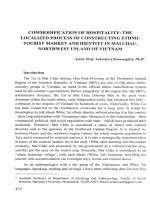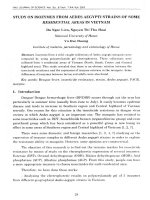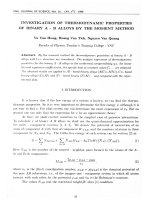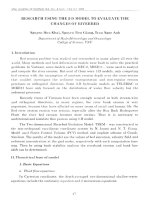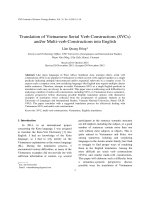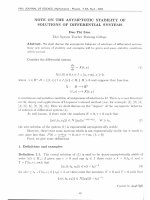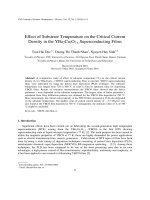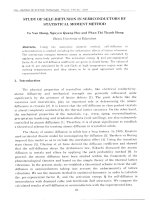DSpace at VNU: Study of the Essential Oil of Limnophila Rugosa (Roth.) Merr. in the South of Vietnam
Bạn đang xem bản rút gọn của tài liệu. Xem và tải ngay bản đầy đủ của tài liệu tại đây (80.17 KB, 8 trang )
This article was downloaded by: [New York University]
On: 01 December 2013, At: 19:31
Publisher: Taylor & Francis
Informa Ltd Registered in England and Wales Registered Number: 1072954 Registered office: Mortimer House,
37-41 Mortimer Street, London W1T 3JH, UK
Journal of Essential Oil Bearing Plants
Publication details, including instructions for authors and subscription information:
/>
Study of the Essential Oil of Limnophila Rugosa (Roth.)
Merr. in the South of Vietnam
a
Nguyen Truc Linh & Le Ngoc Thach
b
a
Faculty of Chemical Technology, University of Cantho , 3/2 Street, Ninhkieu Dist., Cantho
City , Vietnam
b
Department of Organic Chemistry, Faculty of Chemistry , University of Science, Vietnam
National University-HCM City , 227 Nguyen Van Cu Street, Dist 5., Hochiminh City , Vietnam
Published online: 12 Mar 2013.
To cite this article: Nguyen Truc Linh & Le Ngoc Thach (2011) Study of the Essential Oil of Limnophila Rugosa (Roth.) Merr. in
the South of Vietnam, Journal of Essential Oil Bearing Plants, 14:3, 366-372, DOI: 10.1080/0972060X.2011.10643947
To link to this article: />
PLEASE SCROLL DOWN FOR ARTICLE
Taylor & Francis makes every effort to ensure the accuracy of all the information (the “Content”) contained
in the publications on our platform. However, Taylor & Francis, our agents, and our licensors make no
representations or warranties whatsoever as to the accuracy, completeness, or suitability for any purpose of the
Content. Any opinions and views expressed in this publication are the opinions and views of the authors, and
are not the views of or endorsed by Taylor & Francis. The accuracy of the Content should not be relied upon and
should be independently verified with primary sources of information. Taylor and Francis shall not be liable for
any losses, actions, claims, proceedings, demands, costs, expenses, damages, and other liabilities whatsoever
or howsoever caused arising directly or indirectly in connection with, in relation to or arising out of the use of
the Content.
This article may be used for research, teaching, and private study purposes. Any substantial or systematic
reproduction, redistribution, reselling, loan, sub-licensing, systematic supply, or distribution in any
form to anyone is expressly forbidden. Terms & Conditions of access and use can be found at http://
www.tandfonline.com/page/terms-and-conditions
Jeobp 14 (3) 2011 pp 366 - 372
366
Journal of Essential Oil Bearing Plants
ISSN Print: 0972-060X Online: 0976-5026
www.jeobp.com
Study of the Essential Oil of Limnophila Rugosa
(Roth.) Merr. in the South of Vietnam
Nguyen Truc Linh 1, Le Ngoc Thach 2*
Downloaded by [New York University] at 19:31 01 December 2013
1
Faculty of Chemical Technology, University of Cantho,
3/2 Street, Ninhkieu Dist., Cantho City, Vietnam
2
Department of Organic Chemistry, Faculty of Chemistry,
University of Science, Vietnam National University-HCM City,
227 Nguyen Van Cu Street, Dist 5., Hochiminh City, Vietnam
Received 14 February 2010; accepted in revised form 10 December 2010
Abstract: The essential oils of Limnophila rugosa (Roth.) Merr. (Scrophulariaceae) in the south of
Vietnam obtained by hydrodistillation under conventional heating or microwave irradiation showed a slight
difference in chemical compositions. The main constituents of these oils are trans-anethole (24.96-27.12 %)
and methyl chavicol (70.79-71.00 %). In addition, microwave method gave a higher extraction yield in a
considerably shorter time than conventional heating protocol. The physical, chemical and antimicrobial
properties of the oils were also determined.
Key words: Limnophila rugosa, Scrophulariaceae, chemical composition, trans-anethole, methyl
chavicol, microwave hydrodistillation.
Introduction: Limnophila rugosa (Roth.) Merr., an annual herb native to wetlands in Vietnam,
belongs to the Scrophulariaceae family 1,2. It is widely cultivated and used as food flavoring, seasoning
or culinary herb. In addition, the plant is also employed as a traditional medicine for colds, cough,
laxative, diarrhoea, gonorrhea and anaprodisia 3,18. The chemical composition of Limnophila rugosa
(Roth.) Merr. essential oil, obtained by hydrodistillation (steam distillation) with conventional heating,
from several regions including the north of Vietnam, 4,5 China, 6,7 Hungary, 8 and India 9,10,11,18 had been
studied. However, only some of these reports mention the antimicrobial activity of the oils. Moreover,
the essential oil of Limnophila rugosa (Roth.) Merr. from the south of Vietnam has not been studied
yet. Therefore, we decided to investigate this oil in term of both chemical and antimicrobial properties.
Recently, microwave-assisted extraction technique has been applied as a new and efficient method
to isolate essential oils from plant materials. 12 In 1996, we reported that a modified domestic microwave
oven could be used as a heating source for fast hydrodistillation of essential oils from plant materials.13
Unfortunately, this system was subsequently proved to be not applicable for long hydrodistillation
because water is quickly evaporated out of the distillation flask after several minutes.
In this paper, we report the first systematic study of essential oils from the aerial parts of
Limnophila rugosa in the south of Vietnam obtained by hydrodistillation using both conventional
*Corresponding author (Le Ngoc Thach)
E-mail: < >
© 2011, Har Krishan Bhalla & Sons
Le Ngoc Thach et al. / Jeobp 14 (3) 2011 366 - 372
367
heating (HDCH) and microwave irradiation (HDMW). We also introduce a newly-modified Clevenger
type apparatus 14 designed for long hydrodistillation. Oil contents in different parts of the plant and
versus age of material were also studied. The chemical compositions of oil products were analyzed by
GC-MS. The physical, chemical and antimicrobial properties of oils were also investigated.
Downloaded by [New York University] at 19:31 01 December 2013
Experimental
Materials: All Limnophila rugosa samples were collected in the morning in Trang Bang Dist.,
Tay Ninh Province. The plant was identified by the Department of Botany, School of Biology, University
of Science, Vietnam National University-Ho Chi Minh City.
Gas chromatography: GC analyses were performed on an Aglient 6890N GC equipped with
an FID and DB-5 capillary column (30 m x 0.32 mm x 0.25 μm). Nitrogen was used as the carrier at
a flow rate of 1.74 ml/min. The constant pressure mode at 9.32 psi was chosen on GC program. The
oven temperature was programmed from 60°C to 240°C at 3°C/min. The injector and detector
temperature was 250°C. The injection volume was 1.0 μl. The split ratio was 10:1. The percentage
composition of the constituents of the oils was determined by area normalization.
Gas chromatography-mass spectrometry (GC/MS): An Agilent 7890 GC coupled to a 5973A
Network Mass Selective Detector using HP-5MS capillary non-polar column (30.0 m x 0.25 mm x
0.25μm). Helium was employed as the carrier at a flow rate 1.20 mL/min. The constant pressure mode
at 10.604 psi was chosen on GC program. The injection temperature was 250°C; the injection volume
was 1.0 μl; the split ratio was 10:1, and the ionization voltage was 70 eV. The oven temperature was
programmed from 60°C to 240°C at 3°C/min. The retention indices (arithemetic indices) of the oil
components were calculated relative to the homologous series of C9-C17 n-alkanes by using the equation
propounded by van den Dool and Kratz in 1963. Identification of constituents was based on comparing
their mass spectra with those of standard compounds registered in the NIST 2008 library. Moreover,
the identification was also confirmed by the retention indices of each individual constituent relative to
those reported in the literature compiled by Adams 15.
Density of oil products was determined by using glass densitometer, and their [α] 27
were meaD
sured by A. Krüss Optronic polarimeter (Germany).16
Typical hydrodistillation procedure: Fresh aerial parts of the plant (300 g) were cut into small
pieces, loaded onto a Clevenger type apparatus with distilled water (600 ml), and hydrodistilled using
HDCH or HDMW. The oil yield was measured as a function of time. 14
Anti microorganism test: The oil is diluted in dimethyl sulphoxide (DMSO). The concentration
can be calculated as following equations:
C0 = 100 μl-1: concentration of original oil
C1 = 1μl C0 + 9μl DMSO = 10-1 μl-1
C2 = 1μl C1 + 9μl DMSO = 10-2 μl-1
C3 = 1μl C2 + 9μl DMSO = 10-3 μl-1
C4 = 1μl C3 + 9μl DMSO = 10-4 μl-1
The antimicrobial activity of Limnophila rugosa aerial part oil was tested by paper disc method
(standard diameter of 6 mm) on Bacillus subtilis, Escherichia coli, Pseudomonas aeruginosa,
Staphylococcus aureus, and Candida albicans.
Le Ngoc Thach et al. / Jeobp 14 (3) 2011 366 - 372
368
Downloaded by [New York University] at 19:31 01 December 2013
Results and discussion: The extraction yields in correspondence with extraction methods are
shown in Figure 1. The conventional method requires longer time (5 hours) but provides lower yield
(0.1347 %) in comparison with the microwave method (0.1560 % yield in 9 minutes). This result is
consistent with the fact that microwave heating accelerates the evaporation of volatile compounds
from plant materials. Therefore, microwave-assisted extraction has been recently considered as a
“green” technique due to its time and energy efficiency. 17 It should be noted that our newly-designed
apparatus for microwave-assisted hydrodistillation allows water to return to the distillation flask,
thus, providing enough water for long distillation processes. 13
The distribution of essential oils in different parts of plant materials was also investigated. As
illustrated in Figure 2, the leaf of the plant contains the highest amount of essential oil (0.2740 %),
followed by the aerial part after flowering (AF) (0.1994 %), aerial part before flowering (BF) (0.1347
%) and stem (0.0151 %). It was also found that the oil content in the plant is dependent on the age of
plant (nearly peak value observed at four months and slightly leveled off afterwards).
Figure 1. Oil yield vs. the hydrodistillation time of HDMW (left) and HDCH (right)
Figure 2. The oil yields vs. the plant part (left), and changes in oil yield
vs. the age of the plant (right) investigated by HDCH method
Downloaded by [New York University] at 19:31 01 December 2013
Le Ngoc Thach et al. / Jeobp 14 (3) 2011 366 - 372
369
The chemical compositions of the aerial part oil were identified by both GC-FID and GC-MSD
technique as shown in Table 1. Generally, oil products isolated by the two techniques show a slight
difference in oil compositions. For example, the oil obtained by HDCH method indicates the presence
of limonene, coumarin, pentadecane… while these minor components were not found in the oil produced
by HDMW method. In addition, the percentages of major components, trans-anethole and methyl
chavicol, are also variable with the heating methods. On the other hand, these values are considerably
different with that of the oil from China and the north of Vietnam. For example, only 24.96 % of transanethole was found in the oil from the south of Vietnam while the figures for the oil from the north of
Vietnam and China are 89.40 % and 76.39 %, respectively. In contrast, methyl chavicol, the major
component in the oil from the south of Vietnam (70.79 %), occurs as the minor one in the oil from the
north of Vietnam (0.41%) (Table 2).
The chemical constituents of the aerial part after flowering oil (AF) were also identified by GCMS technique. The result indicates a transformation between two major components after flowering.
This can be easily observed by an increasing of trans-anethole (from 24.96 to 30.35 %) and decreasing
of methyl chavicol (from 70.79 to 64.20 %) while the total percentage of these two components remains
unchanged (Table 1). In general, oils isolated by using different techniques show a slight difference in
compositions and abundance. Besides, the oil constituents of the aerial part of Limnophila rugosa
(Roth.) Merr. vary with the geographic position of the herbs. The percentage of each component is
variable with the periods of plant growth.
Physical and chemical properties of aerial part oils isolated by both HDCH and HDMW methods
were also determined (Table 3). 15 In general, the difference between two oils is negligible. However, if
compared with the oils from China and India, the difference becomes significant (Table 4).
The anti-microbial activity of Limnophila rugosa aerial part oil was tested by paper disc method
(standard diameter of 6 mm) on Bacillus subtilis, Escherichia coli, Pseudomonas aeruginosa,
Staphylococcus aureus, and Candida albicans. In addition, a typical fungi (Candida albicans) was
also used to test the antifungal activity of this essential oil. Interestingly, oil obtained from the microwave
method exhibits stronger antimicrobial activity than the one from conventional method (Table 5). The
antibacterial activity of the oil arises from the two main components. The higher antimicrobial activity
of the oil obtained from HDMW method can be attributed to the larger amounts of the two main
components. Previous studies also demonstrated significant anti-bacterial and anti-fungal activities of
this oil. 18,19 Infusion of leaves is used as diuretic and stomachic treatment in the Philippines and
India 18. Moreover, L. rugosa’s oil has antifungal activity toward Candida albicans, which cause
genital infection in human. 20 Further in vitro and in vivo tests are needed to confirm this finding. The
antifungal activity promises a broader usage of L. rugosa’s oil.
Conclusions: Two different techniques (HDMW and HDCH) were used to extract essential oil
from Limnophila rugosa (Roth.) Merr. HDMW method is more efficient to extract main components
(trans-anethole and methyl chavicol). Therefore, HDMW is a suitable technique for extracting essential
oil from plant material containing a large amount of water. HDCH method was applied to investigate
the change in composition of oil versus period of growth. The aerial parts can provide optimal oil yield
after 4 months. Interestingly, a transformation between trans-anethole and methyl chavicol was observed
in the oil of aerial part after flowering. In addition, the leaves were found to give the highest oil yield.
Besides, the essential oil from Limnophila rugosa (Roth.) Merr. indicates significant antibacterial
and fungal activities. Although further testing is needed, it is believed that these results would lead to
a wider application for Limnophila rugosa oil.
1.
References:
Pham, H.H. (2000). Plants in Vietnam. Youth Ed. HCM City. pp 480.
Le Ngoc Thach et al. / Jeobp 14 (3) 2011 366 - 372
2.
3.
4.
5.
6.
7.
Downloaded by [New York University] at 19:31 01 December 2013
8.
9.
10.
11.
12.
13.
14.
370
Ministry of Science, Technology and Enviroment (1996). The Red Book of Vietnam, Botanical
Part. Science and Technology. Hanoi. pp 170.
Do, H.B. (2003). Medicinal Plants and Animals in Vietnam. Science and Technology. Hanoi.
pp 993-994.
Vu, N.L., Nguyen, D. T. and Nguyen, T. T. (1988). Limnophila rugosa (Roth.) Merr. - A rich
sources of anethole. Journal of Pharmacy (4,5) 12-20.
Tran, H.T. (2003). Study of the essential oil of aerial part of Limnophila rugosa (Roth.) Merr.
in Vietnam. Journal of Pharmacy (8) 14-15.
Cheng, B., Yu, X. and Tao, G. (1986). Cultivation of caobajiao (Limnophila rugosa) and
assay of the chemical components of its essential oil. Zhongcaoyao 17(4), 175-181.
Yu, X. and Cheng, B. (1986). Chemical constituents of the essential oil from Limnophila
rugosa. Yunnan Zhiwu Yanjiu 8(1), 103-106.
Kumar, V. and Kapil, V. B. (1983). Essential oil of Limnophila rugosa (Roth.) Merr.. Herba
Hungarica 22(2), 77-81.
Gulati, B.C. and Duhan, S.B.S. (1965). Essential oil of Limnophila rugosa. Indian Oil and
Soap Journal 30(8), 233-236.
Baslas, R.K. and Baslas, K.K. (1968). Essential oil from some exotic plants in Kumaon. II.
Perfumery and Essential Oil Research 59(3), 180-182.
Agarwal, S.G., Thappa, R.K., Vashist, V. N., Atal, C.K. and Gupta, R. (1975). Chemical
examination of the volatile oil of Limnophila rugosa. Indian Journal of Pharmacy 37(4), 99100.
(a) Phutdhawong, W., Kawaree, R., Sanjaiya, S., Sengpracha, W. and Buddhasukh,
D.(2007). Microwave-assisted isolation of essential oil of Cinnamomum iners Reinw. ex Bl.:
Comparison with conventional hydrodistillation. Molecules 12, 868-877.
(b) Iriti, M.,Colnaghi, G.,Chemat, F.,Smadja, J.,Faoro,F. and Visinoni, F. A. (2006).
Histo-cytochemistry and scanning electron microscopy of lavender glandular trichomes following
conventional and microwave-assisted hydrodistillation of essential oils: A comparative study.
Flavour Fragrance Journal 21, 704-712.
(c) Kosar, M., Tunalier, Z., Oezek, T., Kuerkcueoglu, M., Baser, K. and Huesnue, C. (2005).
A simple method to obtain essential oils from Salvia triloba L. and Laurus nobilis L. by using
microwave-assisted hydrodistillation. Zeitschrift fuer Naturforschung, C: J. Biosci. 60, 501504.
(d) Elamrani, A., Zrira, S., Benjilali, B. and Benaissa, M. (2003). Isolation of Moroccan
Rosmarinus eriocalix oil: comparison between hydrodistillation and microwave extraction.
J. Essent. Oil Bearing Plants 6, 1-8.
(a) Le, T.N., Tran, A. H., Ho, T.D., Dang, Q.T.N., Loupy, A., Dang, H.H. and Le, T.Q.
(1996). Microwave-assisted extraction process of the basil oil (South Vietnam). Journal of
Chemistry 34(2), 94-99.
(b) Le, T.N., Tran, A.H. and Vuong, V.M. (1998). Contribution in investigation of the
essential oil of Cinnamomum parthenoxylon Meissn. rooten wood. Journal of Chemistry 36(4),
91-93.
(c) Bui, P.M.N., Nguyen, L.T., Le, T.N., Tran, A.H. and Luu, T.T. (2004). Effect of
microwave irradiation on the composition of essential oil of Piper betel L. Journal of Chemistry
42(2), 139-144.
(a) Le, N.T., Tran, H. A., Cao, N. A., Doan, N.N., Luu, T.X.T., Do, Q.H. and Nguyen, T.
T. T. (2006). Award of “Innovation in Science and Technology” Ministry of Science and
Technology, Vietnam.
(b) Nguyen, D.T.T., Tran, H. A. and Le, N.T. (2008). The essential oil composition of
Eryngium foetidum L. in South Vietnam extracted by hydrodistillation under conventionnal
Le Ngoc Thach et al. / Jeobp 14 (3) 2011 366 - 372
15.
16.
17.
Downloaded by [New York University] at 19:31 01 December 2013
18.
19.
20.
371
heating and microwave irradiation. Journal of Essential Oil Bearing Plants 11(2), 154-161.
(a) Marriott, P.J., Shellie, R. and Cornwell, C. (2001). Gas chromatography technologies for
the analysis of essential oils, Journal of Chromatography A, , 936, 1-22.
(b) Zellner, B.d’A., Bicchi, C., Dugo, P., Rubiolo, P.,Dugo, G. and Mondello, L. (2008).
Linear retention indices in gas chromatographic analysis: a review, Flavour and Fragrance
Journal, , 23, 297-314.
(c) Adams, R. P. (2007). Identification of Essential Oil Components by Gas Chromatography/
Mass Spectrometry. Allured. Carol Stream.
(d) Baser, K. H. C. and Buchbauer G. (2010). Handbook of Essential Oils -Science, Technology,
and Applications. CRC Press. Boca Raton.
AFNOR, (1992). Huiles Essentielles. Paris. pp 37-156.
Chemat, F. and Lucchesi, M.-E. (2006). Microwave-assisted Extraction of Essential Oils, in:
Microwaves in Organic Synthesis. Loupy, A. (Eds). VCH, Weinheim. pp 959-983.
Goutam Brahmachari, (2008). Limnophila (Scrophulariacea): Chemical and pharmaceutical
aspects. The Open Natural Product Journal 1, 34-43.
Kapil, V.P., Sinha, A.K., Sinha, G.K. (1983). Antibacteria and antifungal study of some
essentials oils & their constituents from the plants of Kumaon and its Tarai tract. Bulletin
of Medico-Ethno-Botanical Research IV (3, 4), 124-129.
Ryan, K.J., Ray, C.G. (2004). Sherris Medical Microbiology (4th Ed.). McGraw Hill.
New York.
Table 1. Chemical composition (%) of the aerial parts
(BF and AF) of Limnophila rugosa (Roth.) Merr.
No.
Constituents
1
2
3
4
5
6
7
8
9
10
11
12
13
14
15
16
17
18
19
20
1-Octen-3-ol
3-Octanol
Limonene
Linalool
Methyl chavicol
cis-Anethole
p-Anisaldehyde
4-(1-Methylpropyl)phenol
trans-Anethole
1-(4-Methoxyphenyl)-2-propanol
Caryophylene
Coumarin
α-Caryophylene
Pentadecane
α-Farnesene
Nerolidol
2-(1-Methoxypropyl)phenol
Caryophylene oxide
γ-Gurzunene
Heptadecane
Total
% Oil composition
Before flowering
After flowering
HDCH
HDMW
HDCH
0.18
0.17
70.79
0.26
0.37
0.08
24.96
0.18
0.96
0.11
1.09
0.04
0.13
0.12
99.44
0.10
71.00
0.31
0.46
27.12
0.14
0.22
0.30
0.08
0.08
0.07
99.88
0.73
0.27
0.05
0.28
64.20
0.39
0.03
30.35
1.32
0.21
1.39
0.08
0.03
0.16
0.08
99.57
Le Ngoc Thach et al. / Jeobp 14 (3) 2011 366 - 372
372
Table 2. Comparison of the main constituents of aerial part
oils in the south of Vietnam and other regions
% Oil composition
Southern Vietnam
Northern Vietnam 5
Main constituents
Downloaded by [New York University] at 19:31 01 December 2013
Linalool
Methyl chavicol
p-Anisaldehyde
trans-Anethole
Caryophylene
α-Caryophylene
0.17
70.79
0.37
24.96
0.96
1.09
China 7
0.10
0.41
0.09
89.4
0.74
0.85
0.08
21.94
0.05
76.39
0.08
0.15
Table 3. Physical and chemical properties of oil products
obtained by HDCH and HDMW methods
nD26 , 4
[α
α] 25
D
IA
IE
1.5226
1.5237
+ 0.307
+ 0.289
0.5745
0.5236
2.6552
2.5441
Method
HDCH
HDMW
0.9579
0.9585
IA : Index of Acide ; IE : Index of Ester
Table 4. Comparison of physical and chemical properties of aerial
part oils in the south of Vietnam and other regions
Properties
China7
Southern Vietnam
d
nD
0.9579 30
1.5226 26,4
[α] 25
D
+ 0.30725
- 0.4524
IA
IE
0.57
2.08
0.38
5.32
0.9756-0.9985
1.5283 22
India9
24
India10
0.986 10
1.530-1.53110
0.995922
1.522121
-
-
3.02
31.78
1.15
12.58
Table 5. Anti microorganism properties of Limnophila rugosa (Roth.) Merr. volatile oil
Microorganism
C* = 10 0
Bacillus subtilis
Escherichia coli, ATCC 25922
Staphylococcus aureus, ATCC 25923
Pseudomonas aeruginosa, ATCC 27853
Candida albicans
*C : oil’s concentration (μl-1)
22
16.5
27
13
37.5
Zone of inhibition (mm)
HDCH
HDMW
10 -1 10-2
10 -3 10 0 10 -1 10 -2
9
12
6
7
6
6
8
6
6
6
6
6
6
6
6
23
22
15
11
>60
6
11
6
6
6
6
6
6
6
6
